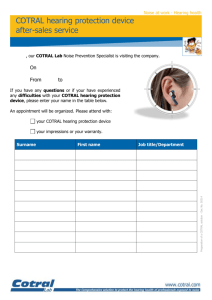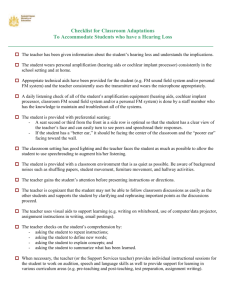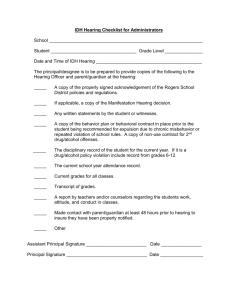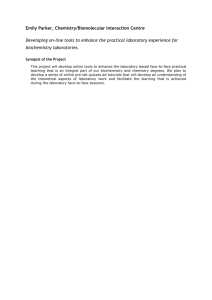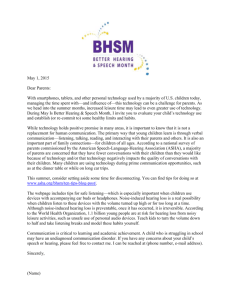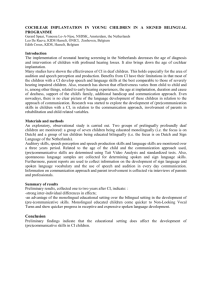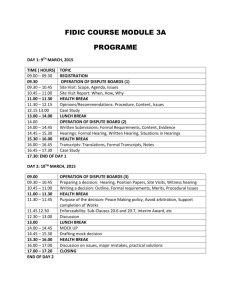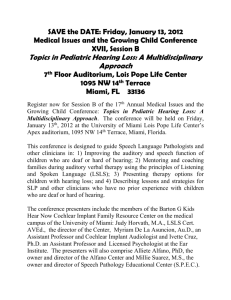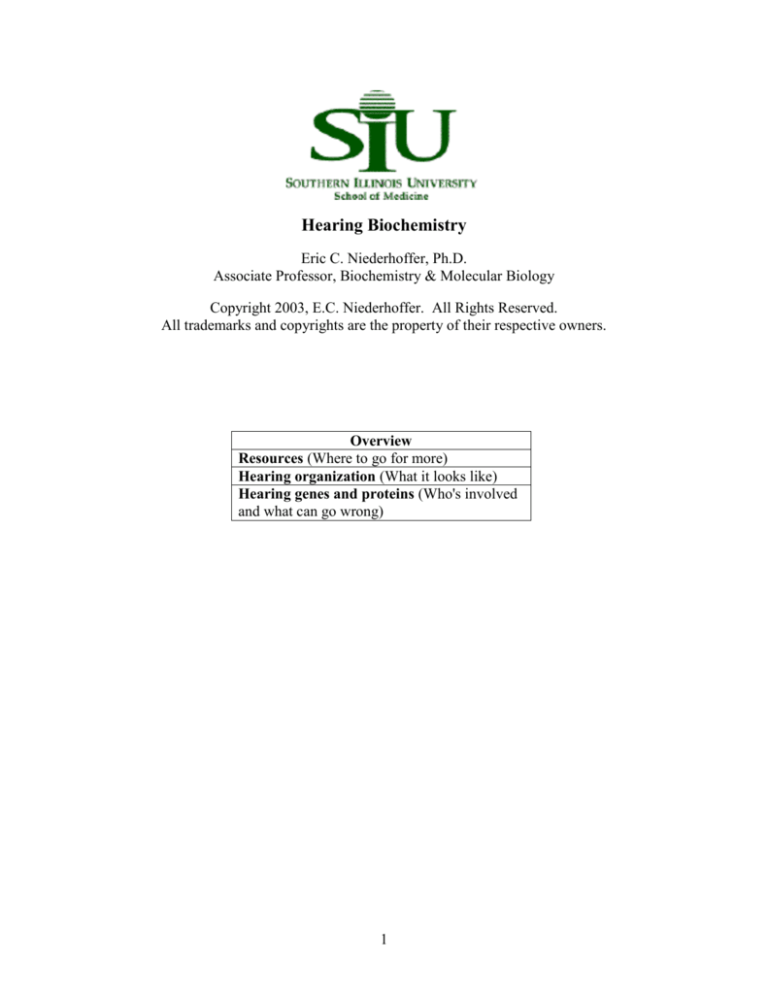
Hearing Biochemistry
Eric C. Niederhoffer, Ph.D.
Associate Professor, Biochemistry & Molecular Biology
Copyright 2003, E.C. Niederhoffer. All Rights Reserved.
All trademarks and copyrights are the property of their respective owners.
Overview
Resources (Where to go for more)
Hearing organization (What it looks like)
Hearing genes and proteins (Who's involved
and what can go wrong)
1
Niederhoffer
Muscle Biochemistry
C2000
Resources
Neuromuscular Home Page (Washington University)
Brown, R. H., Jr., and J. R. Mendell. 2001. Disorders of smell, taste, and hearing, pp.
178-187. In E. Braunwald, A. S. Fauci, D. L. Kasper, S. L. Hauser, D. L. Longo, and J. L.
Jameson (ed.), Harrison's principles of internal medicine, 15th ed. McGraw-Hill, Inc.,
New York.
Petit, C., J. Levilliers, and J.-P. Hardelin. 2001. Molecular genetics of hearing loss.
Annu. Rev. Genet. 35:589-646.
Petit, C., J. Levilliers, S. Marlin, and J-P. Hardelin. 2001. Hereditary hearing loss, pp.
6281-6328. In C. R. Scriver, A. L. Beaudet, W. S. Sly, D. Valle, B. Childs, K. W.
Kinzler, & B. Vogelstein (ed.), The metabolic and molecular bases of inherited disease,
8th ed. McGraw-Hill, Inc., New York.
2
Niederhoffer
Muscle Biochemistry
C2000
Hearing Organization
Human ear
Cochlear duct
Inner hair cell
Hearing Organization
(http://arjournals.annualreviews.org/doi/full/10.1146/annurev.genet.35.1
02401.091224)
Figure 1 (A) Schematic representation of the human ear. The
mammalian ear is composed of three compartments: the outer ear is
made up of the auricle and external auditory canal, the middle ear
contains the ossicles within the tympanic cavity, and the inner ear
consists of six sensory organs, namely the cochlea and the five
vestibular end organs (saccule, utricle, and three semicircular canals).
3
Niederhoffer
Muscle Biochemistry
C2000
Hearing Organization
(http://arjournals.annualreviews.org/doi/full/10.1146/annurev.genet.35.1024
01.091224)
Figure 1 (B) Cross-section through the cochlear duct. The membranous
labyrinth of the cochlea (cochlear duct) divides the bony labyrinth in three
canals, the scala vestibuli and the scala tympani, both filled with perilymph,
and the scala media, filled with endolymph. The organ of Corti, which is the
auditory transduction apparatus, protrudes in the scala media. This organ is
made up of an array of sensory cells (in yellow), i.e., the single row of inner
hair cells (ihc) and the triple row of outer hair cells (ohc); and different types
of supporting cells that include pillar cells (p), cells of Deiters (d), and cells
of Hensen (h). It is covered by an acellular gel, the tectorial membrane. The
organ of Corti is flanked by the epithelial cells of the inner sulcus (is) on the
medial side and by the cells of Claudius (c) on the lateral side. The stria
vascularis, on the lateral wall of the cochlear duct, is responsible for the
secretion of K+ into the endolymph and for the generation of the
endocochlear potential. Different types of fibrocytes surround the cochlear
epithelium. Other abbreviations: (i) interdental cells, (sp) spiral prominence.
(Adapted from a figure drawn by P. Küssel-Andermann.)
Hearing Organization
4
Niederhoffer
Muscle Biochemistry
C2000
(http://arjournals.annualreviews.org/doi/full/10.1146/annurev.genet.35.102401.091224)
Figure 1 (C) Schematic representation of an inner hair cell. Note the highly organized hair
bundle, made of several rows of stereocilia, at the apical pole of the cell. The ribbon
synapse has particular structural and functional features. Three specific structures of the
actin cytoskeleton are shown (in red), namely the filaments of the stereocilia, the cuticular
plate (a dense meshwork of horizontal filaments running parallel to the apical cell surface),
and the cortical network (beneath the plasma membrane). Unconventional myosins form
a large family that has been divided into 16 classes. These motor proteins move along the
actin filaments using the energy generated by the hydrolysis of ATP. The structure of
unconventional myosins consists of (a) the N-terminal motor head containing the highly
conserved actin and ATP-binding sites; (b) a neck region, composed of a variable number
of IQ (isoleucine-glutamine) motifs that are expected to bind to calmodulin; and (c) a tail,
which differs substantially from one myosin to another. The tail sequence determines the
functional specificity of each myosin because it contains various putative protein-protein
interacting domains that bind to cargo molecules, regulatory factors, and components of
the transduction pathways. Unconventional myosins have been implicated in the formation
and the movements of cytoplasmic expansions, in the movements of vesicles and in signal
transduction.
Primary defect
Gene
MYO7A
Hearing Genes and Proteins
Protein
Myosin VIIA
5
Type of molecule
Motor protein
Niederhoffer
Filaments
Nonsensory cells
Tectorial membrane
Unknown
Muscle Biochemistry
MYO15
MYO6
USH1C
CDH23
Espn
KCNQ4
Atp2b2/Pmca2
OTOF
POU4F3
CX26/GJB2
CX30/GJB6
CX31/GJB3
Slc12a2/Nkcc1
PDS
CLDN14
COCH
EYA4
POU3F4
COL11A2
TECTA
Otog
TMPRSS3
PCDH15
HDIA1
DFNA5
MYH9
MTRNR1
MTTS1
C2000
Myosin XV
Myosin VI
Harmonin
Cadherin-23
Espin
KCNQ4
Ca2+-ATPase 2
Otoferlin
POU4F3
Connexin 26
Connexin 30
Connexin 31
NKCC1
Pendrin
Claudin-14
Cochlin
EYA4
POU3F4
Collagen XI (2 chain)
-tectorin
Otogelin
TMPRSS3
Protocadherin-15
Diaphanous-1
Motor protein
Motor protein
PDZ domain-containing protein
Cell adhesion protein
Actin-binding protein
K+ channel subunit
Calcium pump
Vesicle trafficking protein
Transcription factor
Gap junction protein
Gap junction protein
Gap junction protein
Na+K+2Cl- cotransporter
Iodide/chloride transporter
Tight junction component
Extracellular matrix component
Transcriptional coactivator
Transcription factor
Extracellular matrix
Extracellular matrix
Extracellular matrix
Transmembrane serine protease
Cell adhesion protein
Regulator of actin cytoskeleton
Myosin IIA
Motor protein
Mitochondrial 12SrRNA
Mitochondrial tRNAser(UCN)
6
Niederhoffer
Head
Actin-binding, ATPase
Muscle Biochemistry
Myosin
Rod
calmodulin-binding
7
C2000
Tail
variable, binding to other proteins

